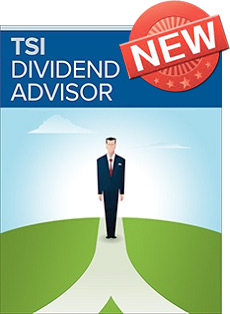I recently had a chance to discuss a new Canadian advisory on dividend stocks with the people responsible for that newsletter. The advisory comes from TSI Network, founded by Pat McKeough, whose investment approach I have always respected.
The advisory is TSI Dividend Advisor (shown above), and it grew out of a long respect for the power of dividends.
Pat and his investment team have always viewed dividends as a sign of investment quality. By extension, dividend stocks become the most reliable foundation of an investment portfolio built for growing wealth and financial independence.
This confidence in dividends is accompanied by a detailed examination of dividend-paying stocks to identify those with the greatest potential to sustain, and raise, their payouts.
The 8 key points they use to evaluate dividend stocks grew into their Dividend Sustainability Ratings. This proprietary ratings system became the backbone of the new TSI Dividend Advisor. It was launched late in 2016 to impressive reviews in the media and a flood of subscriptions from Canadian investors.
Here are some of the keys to that success, from the editors’ point of view.
Jon Chevreau: First of all, Pat, thanks for your time. What role do dividends play in a successful portfolio? How can they lead to Findependence?

Pat McKeough: Top dividend stocks are a key part of a successful portfolio. Top dividend stocks can produce as much as a third of your total return over long periods. These payouts are drawn from earnings cash flow and paid to the shareholders of the company. Typically, these dividends are paid quarterly, although they may be paid annually or monthly as well.
At TSI Network, we think investing in dividend stocks is one of the best investment decisions you can make to achieve Findependence. Dividends serve as a way for companies to share the wealth they accumulate through successfully operating their businesses.
JC: Many stocks have dividends. What makes a top dividend stock?

PM: Top dividend stocks provide steady dividends: a sign of investment quality. Some good companies reinvest profits instead of paying dividends. But fraudulent and failing companies hardly ever pay dividends. So if you only buy stocks that pay dividends, you’ll automatically stay out of almost all the market’s worst stocks. For a true measure of stability, focus on companies that have maintained or raised their dividends during economic and stock market downturns. These firms leave themselves enough room to handle periods of earnings volatility. By continually rewarding investors, and retaining enough cash to finance their businesses, top dividend stocks provide an attractive mix of safety, income and growth.JC: What other benefits do Dividend Stocks offer?
PM: Major benefits can come with Canadian dividend stocks. Canadian taxpayers who hold Canadian dividend stocks get a special bonus. Their dividends are eligible for the dividend tax credit in Canada. This dividend tax credit — which is available on dividends paid on Canadian stocks held outside of an RRSP, RRIF or TFSA — will cut your effective tax rate.
This means that dividend income will be taxed at a lower rate than the same amount of interest income (investors in the highest tax bracket pay tax of around 29% on dividends, compared to roughly 50% on interest income—investors in the higher tax bracket pay tax on capital gains at a rate of 25%.)
Canadian dividend stocks are an important contributor to your long-term gains, and dividend-paying stocks tend to expose you to less risk than non-dividend-payers. That’s why the majority of your stocks should be dividend-payers at all times. When you are retired, you should raise the proportion of dividend-paying stocks in your portfolio, to cut risk and improve the stability of your investment results.
JC: What is the biggest risk associated with dividend investing?
PM: When looking for stocks with high dividend yields, you should avoid the temptation of seeking out stocks with the highest yield — simply because they have above-average yields.
That’s because a high yield may signal danger rather than a bargain if it reflects widespread investor skepticism that a company can keep paying its current dividend.
Dividend cuts will always undermine investor confidence, and can quickly push down a company’s stock price.
Above all, for a true measure of stability, focus on stocks that have a high dividend yield that they have maintained or raised with their dividends during economic or stock-market downturns.
JC: By sector, where might investors find some of Canada’s best dividend stocks?
PM: Some of the top dividend stocks are in the Utilities and Canadian Finance sector. We continue to recommend that you spread your investments out across most if not all of the five main economic sectors (Manufacturing & Industry; Resources; Consumer; Finance; and Utilities). The proportion of your holdings you devote to each sector depends on your temperament and financial goals.
By diversifying across most if not all of the five sectors, you avoid overloading yourself with stocks that are about to slump simply because of industry conditions or investor fashion.
You also increase your chances of stumbling upon a market superstar: a stock that does two to three or more times better than the market average.
However, we think that some of the top dividend stocks are in the Utilities and Canadian Finance sector. You’ll find many of these stocks in our new newsletter TSI Dividend Advisor.
JC: There is no doubt that the Dividend Advisor’s approach to building wealth aligns closely with my approach to creating financial independence. So here is an opportunity to see just how well these two points of view work together. You can have Dividend Advisor at a special “Findependence” discount:
Begin with one free month of Dividend Advisor. Then you may have one full year (12 issues) for: $75 digital delivery only, or $90 digital + print delivery.
When you subscribe to Dividend Advisor, we will also send you a copy of my latest guide to financial independence, Victory Lap Retirement. No extra charge. This offer will expire on March 31, 2017.



